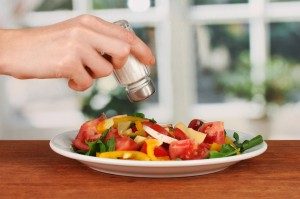Salt seems to the culprit of heart disease and many other serious diseases these days. Food without salt doesn’t taste great but if you want to live longer you might want to reduce the intake of sodium rich salt in your food.
Here are 5 ways to reduce salt in your diet:
- Use fresh rather than processed
Make your own sauces, soups and cooked beans. The ones that come in tins contains lots of sodium
If you are serious about sodium reduction then make these staples in big batches and store them in single-serving portions for later use.
- Be careful in choosing convenience foods
It’s all about making the right choices.Opt for frozen vegetables over canned ones. And when you can’t seek out low or reduced-sodium varieties, rinse the foods in a colander before using to get rid of some of the salt.
You can even take further steps by cutting back or eliminating the additional salt in a recipe that calls for canned goods.
- Add salt only when it will be tasted
Try not to add salt to the water that you use to boil rice, potatoes, pasta or the like. Add it to a dish when its impact will be strongest which is usually at the end of cooking.
A little salt goes a longer way if it’s sprinkled on a food just before serving.
- Measure
Never assume measurements of sodium. Always use measuring spoons when adding it to be sure we’re not overdoing it. Even if a recipe calls for a “pinch” or to “salt to taste,” measure what you are adding, just a little at a time and tasting as you go.
- Confuse your palate
Acidic flavorings like lemon or lime juice and vinegar can help bring out a food’s inherent savoriness, helping you reduce or even eliminate salt.You can even sprinkle fresh grated lemon zest, chopped fresh or dried herbsto help ease the transition to lower-salt cooking by waking up other flavors.Get creative with seasoning blends and just make sure they’re labeled “salt-free.”



















